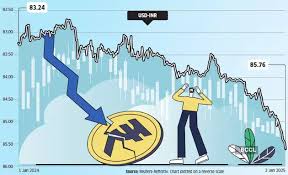
Outline of the Article
H1: Introduction
- Overview of rupee depreciation and its economic implications.
- Importance of understanding its effect on monetary policy.
H2: What is Rupee Depreciation?
- Definition and causes of rupee depreciation.
- Historical trends in the rupee’s value against the dollar.
H2: Current Trends in Rupee Depreciation
- Recent decline against the US dollar.
- Role of global and domestic factors.
H2: Impact of Rupee Depreciation on Inflation
- Link between currency value and import costs.
- India’s reliance on oil imports and its consequences.
- How rising crude oil prices amplify inflationary pressures.
H2: Inflation and Monetary Policy Challenges
- RBI’s inflation targeting framework.
- The balancing act between growth and inflation control.
- Cooling inflation trends in December and their significance.
H2: How Rupee Depreciation Affects Interest Rate Decisions
- Importance of interest rates in managing inflation.
- How a weaker rupee limits RBI’s flexibility for rate cuts.
- Comparison with previous rate-cutting cycles.
H2: Economic Recovery Amidst Rupee Depreciation
- Challenges for India’s economic growth.
- Role of government measures in mitigating economic risks.
- Diverging opinions among economists on the way forward.
H2: Oil Imports and the Trade Deficit
- India’s dependence on oil imports.
- Impact of crude oil prices on the trade deficit.
- Strategies to reduce reliance on oil imports.
H2: Global Economic Factors Influencing Rupee
- Role of the US Federal Reserve’s monetary policy.
- Geopolitical tensions and their effect on emerging markets.
- Capital outflows from India due to global uncertainties.
H2: Policy Measures to Strengthen the Rupee
- RBI’s interventions in the forex market.
- Importance of boosting foreign direct investment (FDI).
- Diversification of foreign exchange reserves.
H2: Future Outlook for the Rupee and Interest Rates
- Scenarios for the rupee’s performance in the coming months.
- Expectations for RBI’s monetary policy actions.
- Long-term implications for economic stability.
H2: Lessons for Emerging Economies
- Managing currency volatility.
- Strengthening economic resilience against external shocks.
- Balancing inflation control and growth priorities.
H2: Key Takeaways for Policymakers and Businesses
- Recommendations for policymakers.
- Steps businesses can take to adapt to currency fluctuations.
- Importance of hedging strategies in uncertain times.
H2: Conclusion
- Recap of rupee depreciation’s impact on interest rates.
- Final thoughts on navigating the challenges.
H2: FAQs
- What is rupee depreciation, and why does it happen?
- How does a weaker rupee impact inflation?
- Can the RBI cut interest rates despite rupee depreciation?
- What role do global factors play in rupee depreciation?
- How can businesses protect themselves from currency fluctuations?
Introduction
The recent depreciation of the Indian rupee against the US dollar has emerged as a pressing concern for India’s economy. As the rupee weakens, its ripple effects extend to inflation, trade deficits, and monetary policy. One significant consequence is the disruption of expectations for interest rate cuts by the Reserve Bank of India (RBI). With inflation concerns mounting, policymakers face a tough balancing act to sustain economic growth while managing price stability. This article delves into the nuances of rupee depreciation and its influence on India’s interest rate outlook.
What is Rupee Depreciation?
Rupee depreciation refers to the decline in the value of the Indian currency compared to foreign currencies, particularly the US dollar. It often results from factors such as:
- Trade imbalances.
- Capital outflows.
- Weak economic indicators.
Historically, the rupee has shown periods of stability punctuated by sharp declines due to external shocks, like the global financial crisis or pandemic-related disruptions. Understanding these trends is key to analyzing the current scenario.
Current Trends in Rupee Depreciation
In recent months, the rupee has fallen to record lows against the US dollar, influenced by both global and domestic factors. On the global front, aggressive interest rate hikes by the US Federal Reserve have strengthened the dollar, prompting capital outflows from emerging markets like India. Domestically, high inflation and a widening trade deficit have further pressured the rupee. This decline underscores the interconnectedness of global and local economic dynamics.
Impact of Rupee Depreciation on Inflation
When the rupee depreciates, the cost of imports rises. India, as a major importer of crude oil, is particularly vulnerable. Crude oil accounts for a significant portion of India’s import bill, and any increase in prices directly impacts inflation.
For example, as crude prices rise, transportation and manufacturing costs escalate, leading to higher prices for goods and services. This creates a domino effect, intensifying inflationary pressures across sectors. The combination of a weaker rupee and high oil prices compounds the challenge for policymakers aiming to curb inflation.
Inflation and Monetary Policy Challenges
The RBI operates within an inflation-targeting framework, aiming to maintain inflation at 4% with a 2% tolerance range. However, the current inflationary environment complicates this goal. While inflation eased to 5.2% in December, the trajectory remains uncertain, influenced by volatile global markets and rupee fluctuations.
Balancing growth and inflation control is no easy task. If the RBI prioritizes growth by cutting interest rates, it risks fueling inflation further. Conversely, focusing solely on inflation control could dampen economic recovery.
How Rupee Depreciation Affects Interest Rate Decisions
Interest rates play a crucial role in managing inflation. A weaker rupee reduces the RBI’s flexibility to lower rates, as doing so could exacerbate inflationary pressures. Historically, rate cuts during periods of rupee depreciation have been rare, given the potential for worsening macroeconomic conditions.
The RBI’s decision-making is also influenced by global factors, such as the US Federal Reserve’s stance. If the Fed continues to hike rates, India may face additional pressure to maintain competitive interest rates, further limiting the scope for cuts.
Continue Generating?
You said:
ChatGPT said:
Economic Recovery Amidst Rupee Depreciation
India’s economic recovery is navigating choppy waters, with rupee depreciation adding to the challenges. A weaker currency inflates import costs, squeezing profit margins for businesses reliant on imported goods and materials. This, in turn, dampens industrial output and weakens consumer purchasing power, slowing down overall economic growth.
Moreover, sectors like manufacturing, infrastructure, and consumer goods face higher operational costs due to elevated raw material prices. While the government has rolled out initiatives to support recovery, such as Production-Linked Incentive (PLI) schemes and infrastructure investments, the effects of these measures are yet to fully materialize.
Economists are divided on the best course of action. Some argue that targeted fiscal measures, such as subsidies or tax relief for key sectors, could provide a much-needed boost. Others stress the importance of monetary discipline to prevent further inflationary spirals.
Oil Imports and the Trade Deficit
India’s heavy reliance on crude oil imports makes it particularly vulnerable to global price fluctuations. Crude oil accounts for approximately 20-25% of the country’s total imports. When the rupee weakens, the cost of these imports rises, inflating the trade deficit.
The widening trade deficit has broader implications, including a depletion of foreign exchange reserves and increased borrowing needs. To address this, India has been exploring alternative energy sources, such as renewable energy and domestic oil exploration. However, these efforts will take time to significantly reduce dependency on imports.
Short-term strategies, such as hedging oil purchases and diversifying trade partnerships, can mitigate some of the risks. Policymakers must also focus on boosting export competitiveness to offset the impact of higher import bills.
Global Economic Factors Influencing Rupee
The rupee’s performance is not solely determined by domestic factors; global economic conditions play a pivotal role. The US Federal Reserve’s aggressive monetary tightening has strengthened the dollar, drawing capital away from emerging markets like India.
Additionally, geopolitical tensions, such as the Russia-Ukraine conflict, have heightened uncertainty in global markets, increasing demand for safe-haven currencies like the US dollar. This has led to significant capital outflows from India, further pressuring the rupee.
To counter these global headwinds, India must focus on building economic resilience. Strengthening trade ties with key partners, maintaining a stable macroeconomic environment, and encouraging foreign investments are critical steps in mitigating external risks.
Policy Measures to Strengthen the Rupee
The Reserve Bank of India has implemented several measures to stabilize the rupee, including interventions in the foreign exchange market. By selling dollars from its forex reserves, the RBI can temporarily curb the rupee’s volatility.
Additionally, the government has introduced policies to attract foreign direct investment (FDI), which can provide a steady inflow of foreign capital. Diversifying the country’s foreign exchange reserves, including holding assets in other major currencies like the euro or yen, can also reduce dependency on the US dollar.
In the long term, fostering self-reliance in key industries and promoting export-oriented growth will strengthen the rupee and reduce vulnerabilities to external shocks.
Future Outlook for the Rupee and Interest Rates
The outlook for the rupee remains uncertain, shaped by both domestic policies and global economic conditions. While some analysts predict further depreciation due to persistent trade deficits and global uncertainties, others are optimistic about the rupee stabilizing if inflation moderates and export performance improves.
On the interest rate front, the RBI is likely to adopt a cautious approach. A pause or minimal rate hikes may be the preferred strategy, allowing the central bank to address inflation without stifling growth. However, the timing and extent of these measures will depend on how inflationary pressures evolve.
Lessons for Emerging Economies
India’s experience highlights important lessons for other emerging economies dealing with currency volatility. Proactive fiscal and monetary policies are essential for managing inflation and sustaining growth. Building robust forex reserves, reducing import dependencies, and diversifying trade partners are critical strategies for mitigating risks.
Furthermore, balancing short-term economic recovery with long-term structural reforms can enhance resilience against external shocks. Emerging economies must also invest in technology, infrastructure, and human capital to drive sustainable growth.
Key Takeaways for Policymakers and Businesses
For Policymakers:
- Focus on stabilizing the rupee through strategic interventions.
- Implement measures to reduce reliance on oil imports.
- Encourage exports by providing incentives to industries with high export potential.
For Businesses:
- Develop robust hedging strategies to mitigate currency risks.
- Explore alternative supply chains to reduce dependency on imports.
- Invest in technology and efficiency improvements to offset rising costs.
Adapting to currency fluctuations requires a collaborative effort between policymakers and businesses to navigate challenges and capitalize on opportunities.
Conclusion
Rupee depreciation poses significant challenges for India’s economy, particularly in the context of inflation and interest rate decisions. While the RBI faces limited room for maneuver, targeted policy measures can help stabilize the situation. The key lies in balancing short-term economic needs with long-term structural reforms to ensure resilience against future shocks.
FAQs
1. What is rupee depreciation, and why does it happen?
Rupee depreciation occurs when the value of the Indian currency falls relative to other currencies, often due to trade deficits, capital outflows, or global economic conditions.
2. How does a weaker rupee impact inflation?
A weaker rupee raises the cost of imports, especially crude oil, leading to higher prices for goods and services, which drives inflation.
3. Can the RBI cut interest rates despite rupee depreciation?
Rupee depreciation limits the RBI’s ability to cut rates, as doing so could further fuel inflation and destabilize the economy.
4. What role do global factors play in rupee depreciation?
Global factors, such as US Federal Reserve rate hikes and geopolitical tensions, strengthen the dollar and increase capital outflows, pressuring the rupee.
5. How can businesses protect themselves from currency fluctuations?
Businesses can adopt hedging strategies, diversify supply chains, and invest in efficiency improvements to mitigate the impact of currency volatility.








